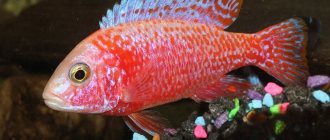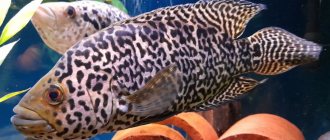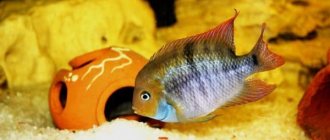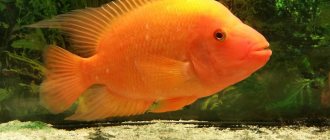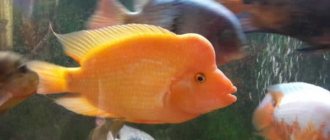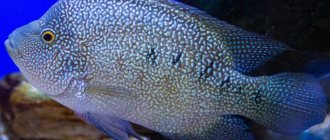Amatitlania nigrofasciata
The genus Cichlasoma has approximately 100 species, but the systematization and classification of this genus is constantly varying and changing. By the way, officially, the genus “Cichlazoma” essentially does not exist at all. They were all distributed into different clans. For example, with the black-striped cichlasoma - generally a guard! She is now Cryptocheros, and even sometimes Archocentrus and Amatitlania. And the diamond cichlasoma (formerly Cichlasoma cyanoguttatum) is now in general, most often Herichthis carpintis. These are the pies, friends!
Black-striped cichlasoma is one of the most popular fish of the cichlasoma family. These are relatively small, unpretentious fish, with a beautiful, sophisticated body color and, importantly, unlike many cichlids, they have a calmer character.
Some might say that the peak of their popularity has passed, that now there are many other more colorful forms of cichlids and cichlases in particular. However, the statistics don’t lie! Today, the black-striped cichlasoma, the most popular of all cichlasomas in the Yandex search. Every month more than 2200 users of this search engine apply for this request.
Black-striped cichlasoma
Well, let's look at this representative of the aquarium world in more detail.
Latin name: Cichlasoma nigrofasciatum - old, new - Amatitlania nigrofasciata. From the Latin words “nigro” - black and “fascia” - ribbon, belt, stripe.
Russian synonyms: Black-striped cichlazoma, black-striped cichlamosis, black-striped cichlamosis.
Foreign names: Zebra Cichlid, Zebra chanchito, Convict Cichlid, Zebrabuntbarsch Grunflossenbuntbarsch, Blaukehlchen.
Order, suborder, family: Perciformes, Perciformes, Cichlidae.
Comfortable water temperature: 20-28 C.
"Acidity" Ph: 6.8-8.0.
Hardness dH: 8-30.
Behavior: 30% are relatively non-aggressive, they show aggression during the period of spawning and caring for offspring.
Content difficulty: easy.
In nature, these cichlazomas live in lakes and streams of Guatemala, Panama, Honduras, Nicaragua and Costa Rica.
Black-striped cichlazoma photo
Description: the body of cichlazoma is tall, slightly elongated in length and compressed on the sides. The head is large, the eyes are large, the lips are thick. The body and fins of cichlazoma are colored grayish-blue, gray. 8-9 black stripes run along the body. The size of the fish in the aquarium reaches a maximum of 10cm. The male is larger and brighter than the female.
History: First described in 1867, first brought to Europe by Johann Paul Arnold in 1934.
Compatibility The black-striped cichlasoma is a surprisingly easy-going fish. And this despite the fact that she is a prominent representative of the aggressive family - cichlids. He has a calm disposition and is friendly even to small neighbors. You can conduct “experiments” with this fish and add relatively compatible fish to it; this issue is described in more detail in this article Compatibility of aquarium fish . As recommendations, it is advisable to keep the black-striped cichlid with other medium and small cichlids: parrot, diamond cichlid. Barbs, gouramis, swordtails and thorns can also get along with them. Black-striped cichlazoma calmly reacts to labeos, bots, thoracatums, and corydoras. However, you need to be careful when it comes to the compatibility of this fish with catfish. After all, the black-striped cichlid spawns at the bottom of the aquarium and the catfish will especially interfere with this process by swimming into the territory of the cichlids. As a result, there will be skirmishes and fights in the aquarium.
Black-striped cichlazoma photo
Incompatible: black-striped cichlasoma will not get along with large and aggressive fish: astronotus, acaras, piranhas. And on the contrary, fish that are too small and slow will not get along with it: small tetras, the family of goldfish, guppies, mollies, and other platies (with the exception of swordtails).
How long do they live: black-striped cichlasomas are a long-lived aquarium fish and can live more than 10-15 years. You can find out how long other fish live HERE!
Minimum aquarium volume: black-striped cichlids are not very large cichlids; an aquarium of 100 liters or more would be best for keeping them. for a couple. However, there have been cases of keeping black stripes in a 50 liter aquarium. In such an aquarium, the fish will be uncomfortable, they will not grow, and the breeding process will be in question. Find out how many other fish you can keep in X aquarium HERE (at the bottom of the article there are links to aquariums of all sizes).
Requirements for care and conditions of maintenance: black-striped cichlazoma is unpretentious in care. Ensuring optimal aquarium water parameters is the key to their successful maintenance and breeding. That is why many aquarists recommend that everyone who wants to start working with cichlids starts with these fish.
Black-striped cichlazoma photo
Perhaps, when keeping the black-striped cichlizoma, special attention should be paid to the bottom and soil of the aquarium, as well as proper zoning of the aquarium.
The fact is that these cichlids really like to “rummage in the soil”, turning it upside down at their discretion. Medium and fine-grained pebbles, gravel, and granite chips can be recommended as soil. Finer soil, for example sand, is not suitable for cichlases.
Zoning of the aquarium is carried out by such decorative elements as: grottoes, rocks, driftwood, caves, etc. Proper division of the aquarium into zones can also be done with the help of plants with a powerful root system, for example, Cryptocorynes or Echinodorus, as well as Vallisneria. At the same time, it is important to root the plants correctly - they are surrounded and pressed down with larger stones and other decor, so that the black-striped cichlids do not dig them up.
If you plan to breed these fish, then the aquarium bottom must also be equipped with a flat stone, a pot, or other similar decoration, which cichlids use as a substrate for spawning. In my opinion, even if you have no particular desire to breed your pets, such decor should be in a pond. After all, an aquarium is an imitation of the natural habitat conditions of fish, and the environment in the aquarium as close as possible to them will be comfortable for the fish.
Filtration, aeration and weekly changes of up to 1/3 of the water volume are also necessary. There are no special requirements for aquarium lighting.
The most important thing is that there are no excessive concentrations of nitrogen compounds and phosphates . This is the main problem for fish that beginners make. Ammonia, nitrite, nitrate, phosphates are the root cause of illness and death in pets. Every conscientious aquarist should always have a set of drop tests on hand, at least for nitrate and phosphate. Fortunately, they have now become inexpensive, there are no problems with their assortment and acquisition. For example, we can with a clear conscience recommend you the cool UHE drop tests, , but they are sold only online. In stores in your city - offline, you can find inexpensive Vladox tests .
When changing water, it would be useful to use clean water supply and use preparations that neutralize harmful substances. For example, Tetra AquaSafe - it removes chlorine compounds, heavy metals + contains B vitamins, iodine and other aquarium goodies. Those. With it, you can safely pour water into the aquarium without fear of harming your beloved pets.
The diet of cichlases is simple - the fish are omnivorous. The ratio of protein food to plant food should be ~ 70% and 30% plant food.
In this regard, we can recommend Tetra Cichlid XL Flakes or Tetra Cichlid XL Sticks. The composition of this food fully meets the needs of the cichlid body for the consumption of proteins and special amino acids + enhances the natural coloring.
Description
Zebra prefers ponds densely overgrown with aquatic vegetation, with hard and warm water. Its protective color makes it invisible in the alternation of light and shadow in reservoirs with a rocky bottom and densely overgrown with various plants. There are 8-9 black stripes on the gray-blue background of the fish’s body.
Depending on the condition of the fish, the color intensity may vary. Chromatophores - cells containing pigment - are able to shrink, and the color of the fish becomes paler. The size of the fish is only 13-15 cm. This little one has a body structure typical for cichlases. The body is oblong, somewhat flattened in the lateral plane, tall, and rather stocky.
The head of cichlazoma is quite large compared to the body. In males, with age, a fatty growth appears in the frontal region. eyes are large, expressive, protected by a leathery fold. The position of the mouth is upper, the lips are large and fleshy. Transparent, sometimes yellowish dorsal and anal fins extend almost to the caudal fin.
There is also a completely depigmented variety of zebra - the albino cichlid. It is more demanding on the composition of water, has less endurance and is more often susceptible to diseases due to reduced immunity. This is not a bred morph, but a genetic anomaly. Albinos are found both in aquariums and in their natural habitat.
Despite the fact that zebra cichlids belong to one of the most aggressive families of fish, they are quite peaceful. The most striking feature of these babies is their fidelity - from juvenile age they form pairs with which they do not part for the rest of their lives. Zebras are faithful spouses and caring parents, whom you can watch endlessly.
Adviсe
- Place the aquarium with black-striped cichlids on a special stand. The volumetric tank is quite heavy to break a cabinet that is not strong enough.
- Gradually adapt the newly acquired black stripes to the conditions of your home pond. Place a bag of fish in a tank filled with water and let the temperatures equalize. After half an hour, gradually pour aquarium water into the bag in small portions.
- Make sure the plants have enough light. The flora, lacking light, dims and withers, growth is drawn in the direction of the light source. Replace the lamp with a more powerful one or install an additional light source.
- Do not buy food in bulk. Always look at the expiration date and read reviews about the manufacturers.
- Do not separate pairs of blackstripes or destroy their spawning areas. Cichlazomas do not form stable pairs throughout their lives and may refuse to spawn in the future with another partner. The spawning site often remains unchanged.
Black-striped cichlasoma is an aquarium inhabitant that remembers its breadwinner. Some aquarists tame the cichlid so that the fish allows itself to be petted and fed by hand. A cichlid can also bite if it doesn't like something.
Previous
FishRarely seen labyrinth fish, Pineapple
Next
Fish10 species of cichlids Aulonocara orchid
How and what to feed cichlasoma
In its natural environment, the black-striped cichlasoma feeds on both animal and plant foods. In the aquarium they are also omnivores - they love to eat fresh or frozen larvae of mosquitoes (bloodworms) or tubifex worms. But with no less pleasure they eat pieces of zucchini, crushed oatmeal, young nettle and dandelion leaves, cabbage, carrots, and spirulina flakes.
To ensure that the fish do not overeat and the pond does not become clogged, baby zebras need to be fed twice a day in such a volume that the fish can eat a portion in 20-30 seconds. Vitamins will not hurt the fish, especially if they are fed with tubifex and scraped meat. They boost immunity and prevent the accumulation of refractory animal fats in the cichlazoma liver. Vitamins are added to dry food or directly to the aquarium water.
Feeding
Blackstripes are omnivores, meaning they eat whatever you offer them. You can feed them with different foods, for example: artificial food for cichlids, vegetable tablets and flakes with spirulina, vegetables, beef heart, bloodworms, tubifex, coretra, brine shrimp.
To avoid contamination with food residues, you need to feed them twice a day in small portions.
Keeping in an aquarium
Black-striped cichlazoma is unpretentious to the conditions of detention. However, the most comfortable conditions are those that are as close as possible to the natural biotope. For a couple, it is enough that the volume of the jar is 40-50 liters. But it should be borne in mind that zebras become aggressive during the spawning period.
They jealously guard their nest and surrounding territory, so you should organize species aquariums or place a couple in a large aquarium so that they have a place to organize a “nursery”. At the bottom it is necessary to organize shelters and zone it with the help of rocks, grottoes, decorative elements or plants.
It is best to use granite chips or pebbles to cover the bottom. Zebras, like most cichlids, love to “build.” The couple will definitely rearrange the bottom to their liking. It will be harder for them to move large stones, but they are needed for zoning, but these fidgets will loosen the sand so that there will always be turbidity in the aquarium.
The more cozy grottoes and rock slides are built, the more likely it is that cichlids will use them for shelter rather than dig trenches and holes in the place of vegetation. To prevent these “landscape designers” from destroying the landscaping of the aquarium, you need to use plants with a powerful root system - echinodorus and cryptocorynes. Their tough leaves will not be used as a dietary supplement.
You can also get the fast-growing Vallisneria spiralis. Vallisneria planted at the back wall of the aquarium forms picturesque impenetrable thickets. In addition to its decorative properties, the plant purifies water from phosphates, nitrates and nitrites, and saturates it with oxygen.
With the help of plants, you can zone the aquarium in order to create secluded corners for cichlids and restore peace and order among its inhabitants. To shade the light and enrich the diet of cichlids with tasty fresh greens, you can place floating plants in the aquarium - duckweed, riccia, pastia, wolfia.
Zebras are not particularly picky about water parameters either. They feel quite comfortable in tap water that has been left standing for 24 hours. The water temperature is 24-27°C, but they can tolerate short-term drops to 18°C and increases to 30°C. The range of fluctuations in hardness is also wide – 8-30°dH. The acid-base balance is better neutral with slight fluctuations in one direction or another (pH 6.5–8).
When keeping one pair of fish in a small aquarium, it is not necessary to use aeration and filtration. They are required for large jar volumes. The flow created by the filter is necessary for the development of eggs. Weekly water changes are 30% of the volume. Lighting can be ordinary - overhead. Fish are not demanding of it. To present zebras in a more advantageous manner, you can organize side or front lighting.
Diseases
Black-striped cichlasoma prefers water temperatures from 24 to 28°C. When kept below 24° degrees, fish may develop ichthyophthyriasis. Signs of this disease: fish scratching on the ground and fins compressed. Also, a white coating in the form of small grains (semolina) appears on the body and fins.
The causative agent of the disease is an equiciliated ciliate parasitizing on the body of fish. Treatment is carried out both in a general and separate aquarium. For more information about fish diseases and the treatment of ichthyophthyriosis, see the publication “Treatment of aquarium fish with bicillin.”
Notes: An undesirable drop in temperature may not be the only cause of an outbreak of ichthyophthyriasis. It is known that the disease ichthyophthyriosis primarily affects fish with a weakened immune system, which can be caused by poor nutrition.
Compatibility with other fish
Among the aggressive and very territorial cichlids, the black-striped cichlid is the most peaceful fish. But she is not the easiest neighbor in a densely populated aquarium. With proper organization of the aquarium space, zebras get along well with neons, swordtails, zebrafish, and barbs. You should not experiment with slow-moving veiled-tailed guppies.
Zebras are not very friendly towards individuals of their own species and genus. During the spawning period, they can even fight with fish several times their size. The literature describes cases of killing plecostomus and oscar catfish, which are three times larger than minke whales, by cichlases.
Zebras behave well in a species aquarium. They can even interbreed with closely related cichlid species, forming interesting hybrids. The population of the bank should be taken into account to prevent conflicts.
Spreading
The black-striped cichlid is a native American species.
It lives in bodies of water located in the central part of the continents, from Guatemala to Hondorus and Panama. These fish prefer to settle at the bottom of clean streams and rivers, hiding in natural caves, grottoes and among roots. Now the fish can be found in fresh water bodies of the United States, especially often in the southern states. It was seen in Southeast Asia and even in Australia.
Most likely, cichlazomas are relatively recent migrants. But, given the tenacity with which they approach the issue of reproduction, we can predict a rapid increase in their numbers and further distribution along the streams and rivers of the planet.
Features of reproduction and breeding
Black-striped cichlazomas spawn all year round - there is no connection to a specific season. They can produce offspring with short breaks necessary to care for the fry. The process can even take place in a common aquarium, but in order to avoid aggression towards neighbors, it is better to place the pair in a separate jar.
To lay eggs, fish use a cave dug in the ground with a thoroughly cleaned bottom. You can arrange a “maternity hospital” for them in a clay pot or tea cup placed on its side, located away from the front glass of the aquarium. Some aquarists create a “fence” in a common aquarium using a frame with a mesh, which allows them to avoid installing a separate filter and monitor the characteristics of the water.
The clutch consists of 300-400 eggs, which are looked after by the female - she fans them with her fins and sorts them. At this time, the male performs “service” on the outer boundaries of the nest. After two days the fry hatch. They are still very weak, and their parents continue to protect them. While one of them carries the babies in his mouth for a “walk,” the second cleans the nest.
When the fry begin to feel confident, you can see the “kindergarten” on a walk with their parents. After the yolk sac disappears, the fry begin to eat Cyclops and Artemia nauplii. Slightly older fry can be given crushed tubifex. Parents, waving their fins, raise a suspension containing food, which the voracious babies actively eat.
Black-striped cichlasoma is not only a beautiful fish. It is interesting to watch her all year round - both during spawning and while caring for numerous babies. Funny fish are constantly on the move - playing, caring for their partner, arranging a comfortable home. They cannot get bored, so they retain the affection and love of aquarists.
Starter feed
The best food for swimming fry is plankton: ciliates, rotifers, small daphnia. But you can get plankton in spring and summer, and even then only if the body of water in which it is found is known. A way out may be to breed live food at home.
For example, is Daphnia moina not an excellent food for swimming fry? Small moin nauplis will be the most valuable starter food at this time. In addition, over time, the grown fry can be fed with grown crustaceans. It is very profitable and convenient! It is not difficult to dilute moin. Read more in the publication “Food for Daphnia fish”. The second option for providing the fry with valuable starter food would be brine shrimp.
The only, but very significant drawback of Artemia crustaceans is that they live in demineralized water for only a short time, and the fry need constant nutrition. You can try to feed the fry with artificial food, for example, boiled yolk, as well as special food produced by industry, but the result of such food, believe me, is not at all pleasing.
Photo of black-striped cichlases
Reviews
There are the most mixed reviews about these fish. On the one hand, these are one of the most unpretentious and beautiful aquarium species, and on the other hand, they are predators. Cichlazomas share everything from food to territory. If the volume of the aquarium is small, then larger fish may well eat small ones even from their droppings. When the fry grow up, they must be removed, because the parents, laying claim to the territory, can eat them. If the babies are transplanted in time, then breeding with cichlases can become an easy and profitable process.
Cichlid lovers complain that cichlids are difficult to live with during spawning. During this period, they chase and bite other aquarium fish, so you need to be careful when adding another type of fish to cichlids, carefully observing the result. In a word, the black-striped cichlasoma is a beautiful pet with a difficult character.
Kinds
Like any other type of fish, cichlazomas have varieties:
Albino
This formulation assumes that the body of a fish (or any other creature) does not produce a coloring pigment at all. This is a genetic deviation that distinguishes fish from others of its species only by its external color. This does not affect behavior or condition. In nature and in artificial conditions, albinos are not uncommon. However, they have weaker immunity;
